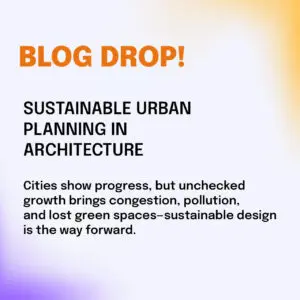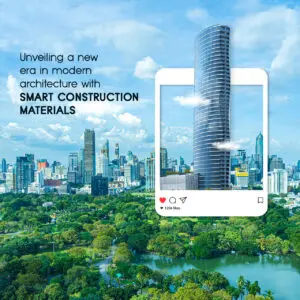
Architects have a fundamental responsibility to design environments that are both visually appealing and environmentally responsible in a world that is having difficulty with climate change and growing cities. Students pursuing a Bachelor of Architecture (B.Arch) must therefore develop a mindset based on sustainable architectural design.
At OmDayal Group of Institutions, we want to equip the students with the knowledge and skills to design buildings which blend in with their environment so that the students can gear up towards the future of architecture. Let’s examine the fundamentals of eco-friendly living and sustainable practices that all B.Arch students must understand and then apply throughout their architectural careers.
1. Getting Started with Sustainable Design
Sustainable design in architecture strives to enhance the quality of life of building occupants and mitigate negative impacts, which is accomplished through the balance of three important bases:
- Environmental: Emphasizing resource conservation and waste reduction.
- Economic: Providing a fair price for the service and product; but not at the cost of quality.
- Social: Creating environments that enhance the quality of life of people.
Architecture students, in order to start thinking this way, would need to think of a design not just a building, but instead an ecosystem that not only interacts with humans, but resources and the natural environment.
2. Passive Design Techniques
One of the best ways to make a building sustainable is through passive design, which controls indoor comfort by utilizing natural elements like sunlight, wind, and vegetation.
Proper orientation of a building to maximize daylight can help decrease energy consumption. Cross-ventilation designs can help lessen the dependence on air-conditioning. Structures that offer shade, like pergolas or louvers, can help lessen heat gain.
These lessons can be useful for B.Arch students because making deliberate and considered design decisions is often the simplest way to begin embracing sustainability.
3. Selecting Sustainable Materials
The materials used to construct a building can counter the building’s carbon footprint. The goal of sustainable architectural design is to minimize transportation emissions through the use of materials harvested locally. Choosing renewable or recycled materials such as bamboo, fly-ash bricks or reclaimed timber. Low volatile organic compound (VOC) paint and finish selections improve indoor air quality is an excellent alternative.
4. Improving Energy Efficiency and Renewables
Today, the energy use of buildings is a serious problem. The architect can only begin to address the problem of energy use by working with energy-efficient lighting and appliances, using solar panels or photovoltaic systems for renewable energy, and intelligent systems for buildings that record and minimize energy waste.
Students need to learn how to utilize these systems with attractive looks.
The ultimate goal of green architecture is to create net-zero energy buildings: buildings that consume no energy beyond what they generate.
5. Water Management and Waste Conservation
- Sustainability is about far more than energy. Thoughtful design also seeks to maximize water efficiency and minimize waste.
- Installing rainwater collection systems.
- Constructing a landscape irrigation system that uses recyclable greywater.
- Using permeable pavement to minimize stormwater runoff.
- Encouraging on-site composting and waste diversion.
- With these systems in place, students begin to realize how architecture affects the sustainable living choices we make each day.
6. Biophilic and Human-Centered Design
A fundamental goal of sustainable design is to reduce energy and resource consumption, but it can also promote people’s health and well-being. Biophilic design – a specific approach to sustainable design – helps a place remain productive, mental health supportive, and socially-inclusive by simply bringing in natural light, natural ventilation, plants, and open (unobstructed) space.
Sustainable buildings are not only “green” buildings; they are buildings that make their occupants happier, healthier, and more connected to the natural world. Any B.Arch student considering a career in architecture should be aware of this.
7. Learning from Vernacular Architecture
India’s architectural legacy offers timeless lessons about sustainability. Traditional homes with courtyards, thick walls, and clay tiles were able to naturally adapt to the climate without the aid of modern technology.
Studying vernacular architecture teaches students how local resources and expertise can impact creative, eco-friendly approaches to contemporary design.
8. Innovation and Ongoing Learning
Lastly, the field of designing sustainable architecture is still in its infancy. The landscape is continuously shifting due to new materials, digital tools like BIM, and international green building standards like LEED and GRIHA. By embracing their curiosity and staying up to date with developments, students can stay at the forefront of their field.
Every design decision, from the choice of materials to building orientation, has the power to shape the way that communities live and how our planet survives.
Here at OmDayal Group of Institutions, we encourage students to see beyond simple blueprints and design with purpose, responsibility, and imagination. We feel that the designers of the future are not only builders of structures but also the stewards of a sustainable world.
Sources:
- https://www.morphogenesis.org/media/vernacular-architecture-and-its-importance-in-modern-india/?utm_source=
- https://www.iiad.edu.in/the-circle/learning-passive-design-from-rural-india/?utm_source=
- https://ongrid.design/blogs/sustainable/passive-architecture-indian-homes?srsltid=AfmBOor7ogNJ4RA2yu0_H8Jvx-lpzneJv7JWBJX6cwqdWf-XSSpLbZ4f&utm_source=




